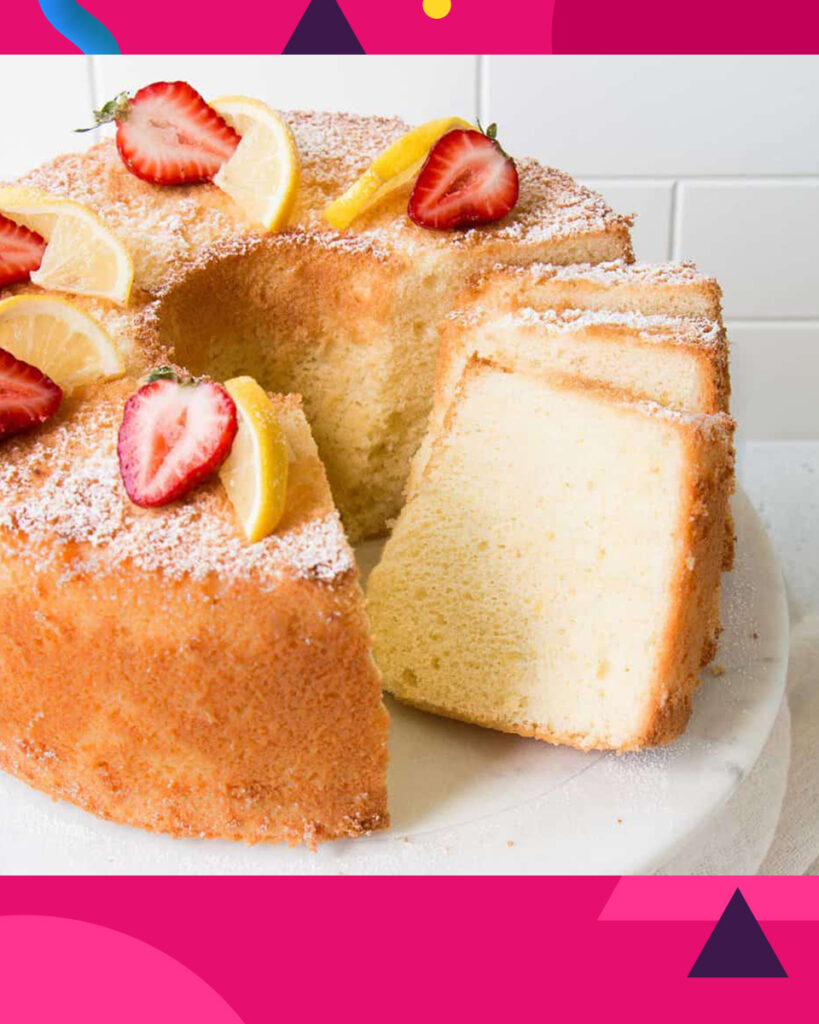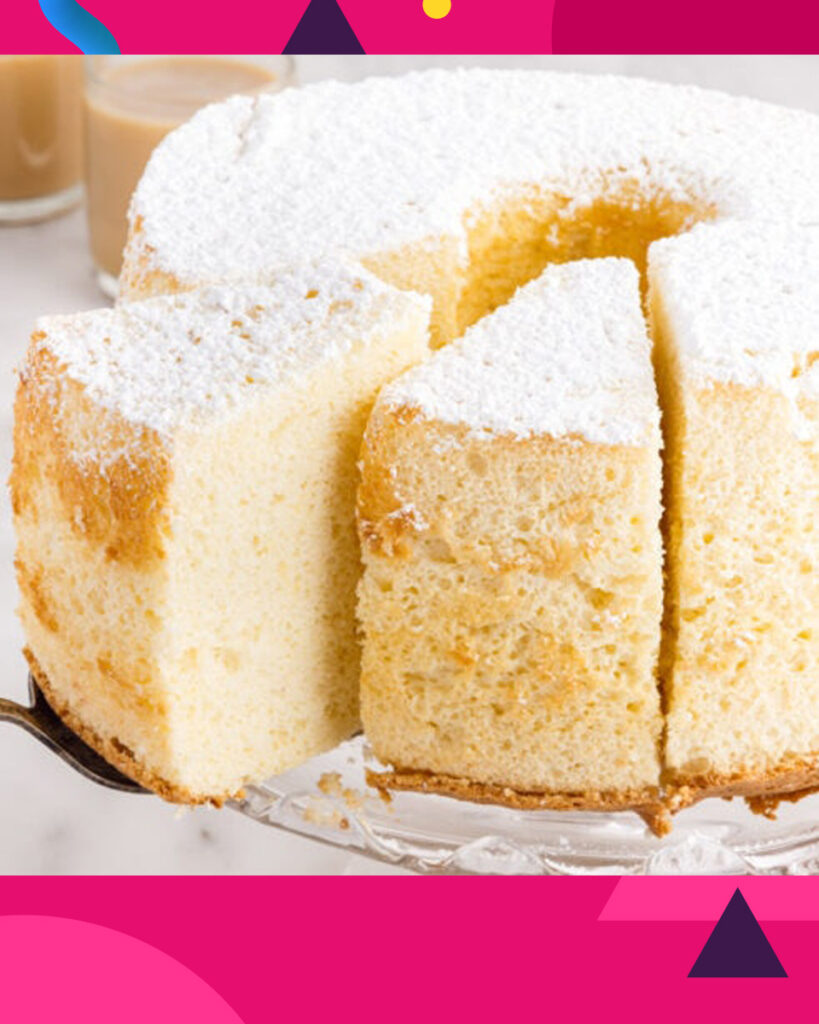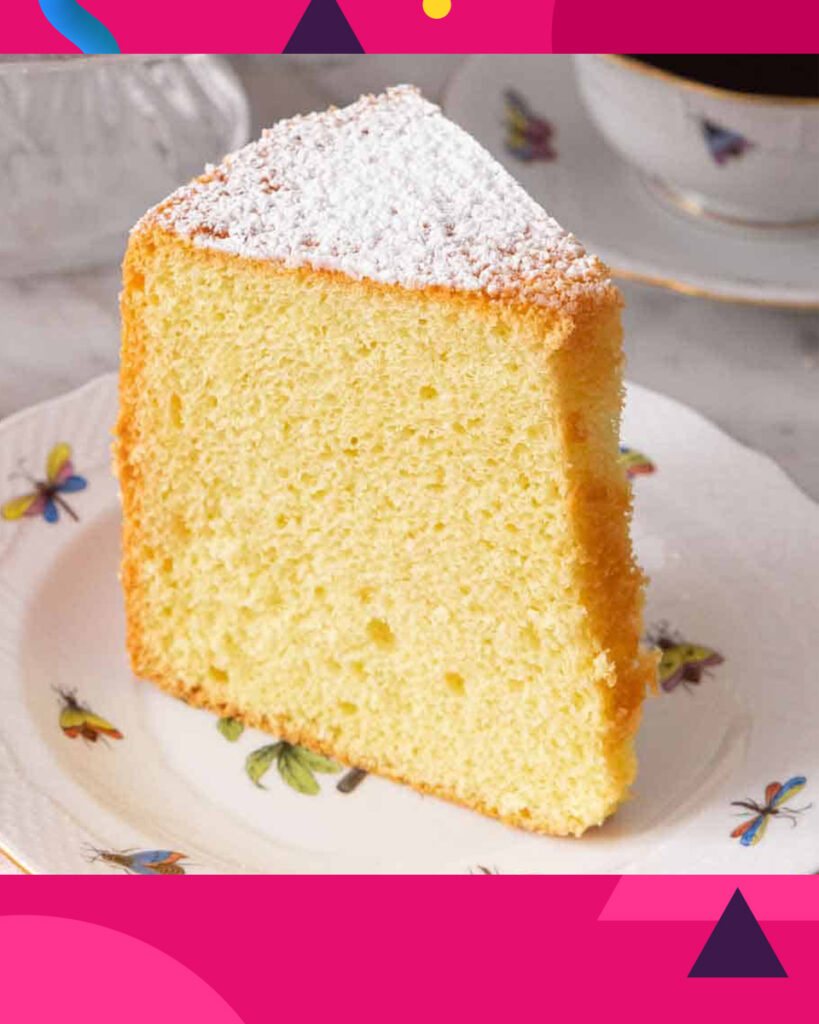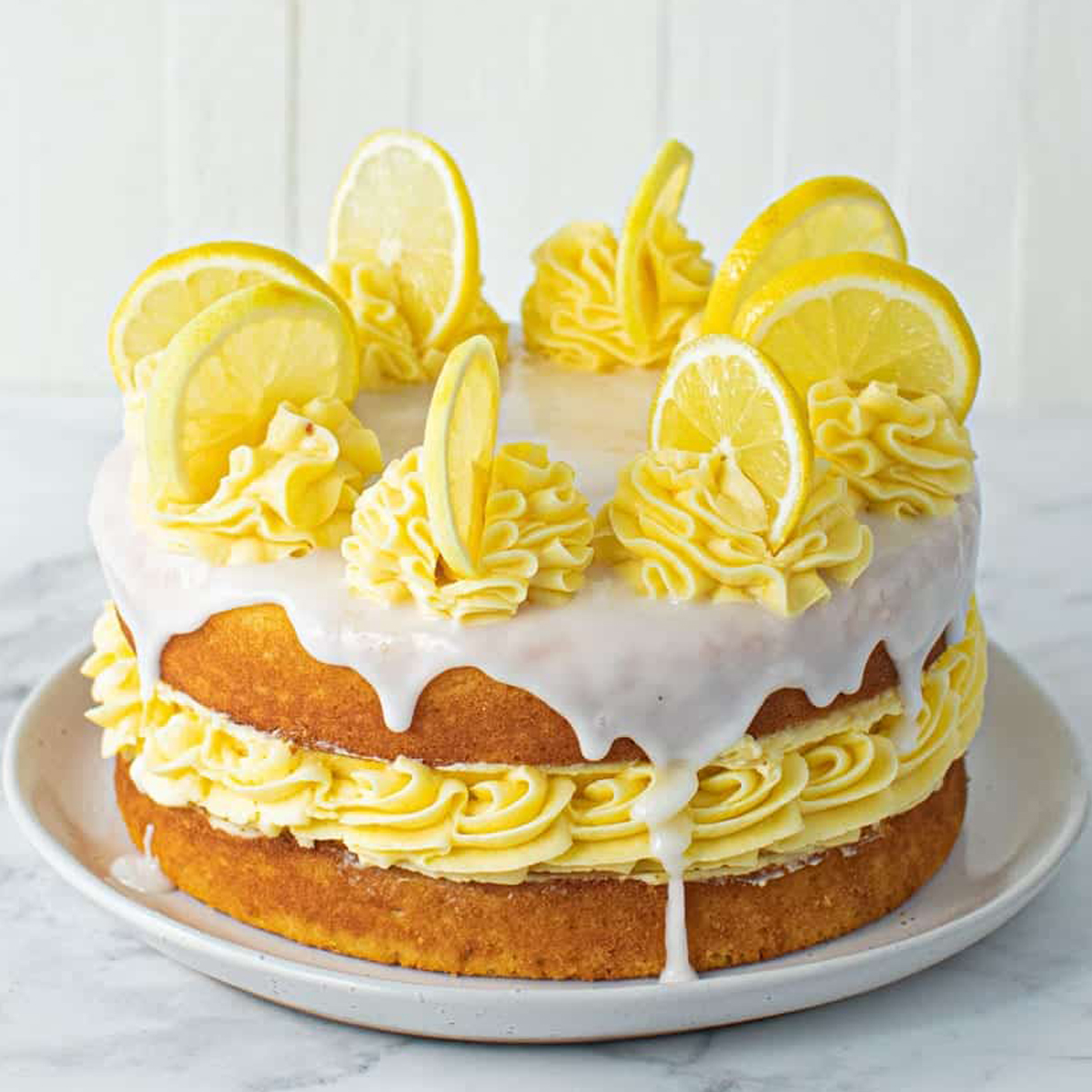Indulge in the airy and light decadence of Chiffon Cake, a true delight for cake enthusiasts. This classic dessert stands out for its unique texture and exquisite taste, striking the perfect balance between the richness of a butter cake and the fluffiness of a sponge cake. Created in the 1920s, Chiffon Cake was a culinary breakthrough that revolutionized cake baking with its use of vegetable oil, which contributes to its remarkable lightness and moist crumb.

Made with a simple yet harmonious combination of flour, sugar, eggs, vegetable oil, and baking powder, the magic of Chiffon Cake lies in its technique. Beating the egg whites separately and folding them gently into the batter creates the cake’s signature airy texture, elevating it to a level of elegance that’s ideal for any occasion, from casual gatherings to formal celebrations.
Versatile and delightful, Chiffon Cake comes in a variety of flavors, from classic vanilla to zesty citrus and rich chocolate. Its tender and fluffy nature makes it a perfect canvas for a wide range of frostings, glazes, and toppings. Served with a dollop of whipped cream, fresh fruits, or a dusting of powdered sugar, Chiffon Cake promises a memorable experience that leaves you craving more. Discover the timeless charm of Chiffon Cake and let its heavenly lightness whisk you away on a gustatory journey that’s sure to captivate your senses.
What Is Chiffon Cake?
Chiffon Cake is a type of light and airy cake that falls in between the richness of a butter cake and the fluffiness of a sponge cake. It was invented in the 1920s by Harry Baker, a Californian insurance salesman, and it quickly gained popularity for its unique texture and delightful taste.
What sets Chiffon Cake apart from other cakes is the inclusion of vegetable oil instead of solid fat like butter or shortening. The use of vegetable oil gives the cake a tender crumb and a moist texture. Additionally, Chiffon Cake is known for its high egg content, which contributes to its lightness.
The key technique in making Chiffon Cake is separating the egg yolks from the egg whites. The egg yolks are combined with sugar and oil to form the cake’s base, while the egg whites are whipped to stiff peaks and then gently folded into the batter. This folding process incorporates air into the batter, creating the cake’s fluffy and airy structure.
Chiffon Cake is incredibly versatile and can be flavored with various extracts, zests, or cocoa powder to create different flavor variations. It can be enjoyed plain, dusted with powdered sugar, or frosted with glazes, icings, or whipped cream. It’s often served as a delightful dessert or enjoyed with a cup of tea or coffee.
Due to its light and delicate nature, Chiffon Cake is best stored at room temperature and consumed within a day or two after baking to retain its freshness and texture. It’s a beloved classic that continues to charm cake enthusiasts with its unique blend of richness and lightness.

Why You Will Love Chiffon Cake Recipe?
You will love the Chiffon Cake recipe for a variety of reasons, each of which contributes to its delightful appeal:
- Light and Airy Texture: Chiffon Cake’s unique technique of folding whipped egg whites into the batter creates a light and airy texture that melts in your mouth. The cake feels incredibly soft and fluffy, making it a joy to eat.
- Moist and Tender Crumb: The use of vegetable oil in the recipe ensures that Chiffon Cake remains moist and tender even after a few days, unlike some other cakes that tend to dry out quickly.
- Versatility of Flavors: Chiffon Cake can be easily adapted to suit different flavor preferences. Whether you prefer classic vanilla, zesty lemon, rich chocolate, or any other flavor, the recipe is versatile enough to accommodate various extracts and additions.
- Perfect for Any Occasion: Its elegant appearance and lightness make Chiffon Cake a perfect dessert for both casual gatherings and special occasions. It’s equally suitable for a family brunch or a formal celebration.
- Unique Baking Technique: The process of separating egg yolks and egg whites and then folding them into the batter is a fun and unique baking technique that sets Chiffon Cake apart from other cakes.
- Simplicity of Ingredients: The Chiffon Cake recipe uses basic ingredients that are likely already in your pantry, such as flour, sugar, eggs, vegetable oil, and baking powder. This makes it easy to whip up this delectable treat whenever the mood strikes.
- Pairing Possibilities: Chiffon Cake pairs beautifully with a variety of toppings and fillings. Whether you prefer a simple dusting of powdered sugar, a glaze, a drizzle of chocolate, fresh fruit, or whipped cream, there are endless ways to enhance the cake’s flavor and presentation.
- Long Shelf Life: While best enjoyed fresh, Chiffon Cake retains its quality for longer than some other cakes, thanks to its moist texture and oil-based recipe.
- Impressive Yet Approachable: The light and airy appearance of Chiffon Cake makes it an impressive dessert that can wow your guests, yet the recipe itself is approachable and achievable for bakers of all skill levels.
- A Classic Dessert with a Twist: Chiffon Cake offers a delightful twist on traditional cake recipes, introducing a whole new level of indulgence with its ethereal texture and subtle sweetness.
In summary, the Chiffon Cake recipe presents an alluring combination of lightness, versatility, and deliciousness that is sure to win over your taste buds and elevate your baking repertoire. Its enchanting flavors and delightful presentation will make you fall in love with this timeless and unique dessert.

Ingredients For Chiffon Cake
- 2 and 1/4 cups (270g) cake flour
- 1 and 1/2 cups (300g) granulated sugar, divided
- 1 tablespoon baking powder
- 1 teaspoon salt
- 1/2 cup (120ml) vegetable oil
- 6 large eggs, separated (at room temperature)
- 3/4 cup (180ml) water or any liquid of your choice (e.g., milk, fruit juice, coffee)
- 1 tablespoon pure vanilla extract
- 1/2 teaspoon cream of tartar (optional, helps stabilize whipped egg whites)
Optional Flavors:
- 1 tablespoon grated lemon or orange zest (for a citrusy flavor)
- 1/4 cup cocoa powder (for a chocolate variation)
How To Make Chiffon Cake
- Preheat and Prepare: Preheat your oven to 325°F (160°C). Prepare a 10-inch (25cm) tube pan or chiffon cake pan by ungreasing it with a removable bottom. Avoid greasing the pan, as the cake needs to cling to the sides to rise properly.
- Dry Ingredients: In a large mixing bowl, whisk together the cake flour, 1 cup of granulated sugar, baking powder, and salt. If you’re making a chocolate variation, sift in the cocoa powder as well. Set aside.
- Mixing Wet Ingredients: In a separate bowl, combine the vegetable oil, egg yolks, water (or any liquid of your choice), and pure vanilla extract. If you’re adding citrus zest for flavor, mix it in as well.
- Whip Egg Whites: In another clean and grease-free bowl, beat the egg whites with an electric mixer until they become frothy. Add the cream of tartar (if using) and continue beating until soft peaks form. Gradually add the remaining 1/2 cup of granulated sugar, and continue beating until stiff peaks form. The egg whites should hold their shape when the beaters are lifted.
- Combining Mixtures: Gently fold the egg yolk mixture into the dry ingredients until just combined. Be careful not to overmix to maintain the cake’s lightness.
- Incorporating Egg Whites: Gently fold the whipped egg whites into the batter in three additions. Be gentle to preserve the airiness of the whipped egg whites.
- Filling the Pan: Pour the batter into the ungreased tube pan, spreading it evenly.
- Baking: Bake the Chiffon Cake in the preheated oven for approximately 55-65 minutes, or until a toothpick inserted into the center comes out clean.
- Cooling: Once the cake is done baking, remove it from the oven and immediately invert the pan onto a cooling rack. Let the cake cool completely in the pan. This step helps the cake maintain its volume and prevents it from collapsing.
- Unmolding: Once the cake is completely cooled, run a knife around the edges of the pan to release the cake. Carefully remove the cake from the pan, and it’s ready to be served.
Note: For a traditional Chiffon Cake, avoid using a non-stick tube pan, as the cake needs to cling to the sides to rise properly. Also, resist the urge to grease the pan or use baking spray.
Feel free to get creative with the flavors and toppings to customize your Chiffon Cake and make it your own! Enjoy the light and airy delight of this classic cake.

How To Serve Chiffon Cake
Serving Chiffon Cake is a delightful experience, and there are various ways to present and enjoy this light and airy dessert. Here are some serving suggestions for Chiffon Cake:
- Plain and Simple: Serve the Chiffon Cake as is, without any additional toppings or frostings. Dust the top with a sprinkle of powdered sugar for a touch of elegance. This allows the delicate flavors of the cake to shine through.
- Whipped Cream: Accompany the Chiffon Cake with a dollop of freshly whipped cream. The creaminess of the whipped topping complements the light texture of the cake, creating a heavenly combination.
- Fresh Fruits: Garnish the Chiffon Cake with a selection of fresh fruits like berries, sliced peaches, or kiwi. The natural sweetness of the fruits adds a refreshing twist and a burst of color to the presentation.
- Glaze or Syrup: Drizzle a thin glaze or syrup over the top of the cake. You can use citrus glazes, chocolate ganache, or even fruit syrups to enhance the flavor and appearance.
- Fruit Sauce: Serve Chiffon Cake with a side of fruit sauce, such as raspberry or strawberry sauce. The tangy fruit sauce complements the sweetness of the cake and adds a touch of sophistication.
- Custard: Pair the Chiffon Cake with a creamy custard, such as crème anglaise or lemon curd. The velvety texture of the custard contrasts beautifully with the lightness of the cake.
- Ice Cream: For a decadent treat, serve a slice of Chiffon Cake with a scoop of ice cream. The combination of warm cake and cold ice cream creates a delightful contrast in temperature and texture.
- Caramelized Fruits: Top the cake with caramelized fruits, such as caramelized apples or bananas. The caramelization process intensifies the fruit’s sweetness and adds depth to the overall flavor.
- Coffee or Tea: Pair a slice of Chiffon Cake with a cup of coffee or tea for a classic and comforting dessert experience.
- Garnish with Zest: Sprinkle some citrus zest, such as lemon or orange, over the top of the cake for a burst of citrusy aroma and flavor.
Remember to serve the Chiffon Cake on a beautiful cake stand or dessert plate to enhance its presentation. Whether it’s for a special occasion or a simple family gathering, Chiffon Cake’s lightness and versatility make it a crowd-pleasing dessert that’s sure to impress. Enjoy this delightful cake in the company of friends and family, and savor the delicate flavors and airy texture that make Chiffon Cake a beloved classic.

How To Store Chiffon Cake
Storing Chiffon Cake properly is essential to maintain its light and airy texture and to keep it fresh for as long as possible. Here are some tips on how to store Chiffon Cake:
- Cooling Completely: Before storing the Chiffon Cake, ensure that it has cooled completely. Allow it to cool in the pan for about 10-15 minutes after baking, and then invert the pan onto a cooling rack to cool it further. Cooling the cake properly helps it retain its volume and prevents it from collapsing.
- Unmolding Carefully: Once the Chiffon Cake has cooled completely, use a knife to gently loosen the edges of the cake from the pan. Carefully remove the cake from the pan and place it on a serving plate or cake stand.
- Room Temperature Storage: Chiffon Cake is best stored at room temperature in a cool and dry place. If the weather is hot and humid, it’s better to place the cake in a cake keeper or under a cake dome to protect it from moisture.
- Covering the Cake: To prevent the cake from drying out, cover it loosely with plastic wrap or aluminum foil. Make sure the wrap does not touch the surface of the cake, as this may mar its appearance.
- Avoid the Refrigerator: Unlike some other cakes, Chiffon Cake should not be stored in the refrigerator. Refrigeration can dry out the cake and affect its texture.
- Best Consumed Fresh: Chiffon Cake is best enjoyed within the first day or two after baking. Its light and airy texture are at their peak freshness during this time.
- Freezing: If you have leftover Chiffon Cake that you won’t consume within a day or two, you can freeze it for longer storage. Wrap the cake tightly in plastic wrap and then in aluminum foil or place it in an airtight container. Label with the date and freeze for up to 2-3 months.
- Thawing Frozen Cake: When you’re ready to enjoy the frozen Chiffon Cake, remove it from the freezer and let it thaw at room temperature. To refresh the cake, you can briefly warm individual slices in the microwave.
Remember that Chiffon Cake is delicate and tends to absorb odors, so avoid storing it near strong-smelling foods. Properly stored, Chiffon Cake will remain delicious and satisfying for a short period, allowing you to enjoy its ethereal texture and delightful flavors to the fullest.
Other Delicious Dessert Recipes To Try
FAQs And Troubleshooting
Frequently Asked Questions about Chiffon Cake:
- Can I use all-purpose flour instead of cake flour?
Yes, you can substitute all-purpose flour for cake flour if you don’t have cake flour on hand. However, the texture may be slightly different, as cake flour has a lower protein content, resulting in a more tender crumb. - Can I use other types of oil instead of vegetable oil?
Yes, you can use other neutral-flavored oils like canola or sunflower oil as a substitute for vegetable oil in the Chiffon Cake recipe. - Can I use other flavors instead of vanilla extract?
Absolutely! The Chiffon Cake recipe is quite versatile, and you can experiment with different extracts like almond, lemon, or orange extract to add unique flavors to the cake. - Can I omit the cream of tartar?
While cream of tartar helps stabilize whipped egg whites, you can omit it if you don’t have it on hand. The egg whites may take slightly longer to whip to stiff peaks, but the cake should still turn out well. - Can I bake Chiffon Cake in a regular cake pan?
Chiffon Cake requires a tube pan or chiffon cake pan with a removable bottom to help it rise properly. Avoid using regular cake pans with non-removable bottoms, as they may hinder the cake’s rise.
Troubleshooting Common Issues with Chiffon Cake:
- Collapsed Cake: If the Chiffon Cake collapses after baking, it could be due to underbaking or underwhipping the egg whites. Make sure the cake is fully baked and the egg whites are whipped to stiff peaks before folding them into the batter.
- Dense Texture: A dense Chiffon Cake may result from overmixing the batter or using too much oil. Gently fold the ingredients together until just combined, and measure the oil accurately.
- Tough Crust: An excessively tough crust may occur if the cake is cooled in a humid environment or if it’s covered too tightly. Loosely cover the cake during cooling to prevent this issue.
- Sticking to the Pan: Chiffon Cake should cling to the sides of the pan to rise properly. If the cake sticks, it could be due to greasing the pan or using a non-stick pan. Use an ungreased tube pan for best results.
- Uneven Baking: Uneven baking can occur if the oven temperature is not accurate or if the cake is placed too close to the oven walls. Use an oven thermometer to check the temperature and ensure the cake is placed in the center of the oven.
By following the recipe closely, troubleshooting common issues, and making adjustments as needed, you can achieve a perfect and delightful Chiffon Cake that will impress your friends and family with its light and airy texture and delicious flavor.

Tips And Tricks For Chiffon Cake
Here are some helpful tips and tricks to ensure your Chiffon Cake turns out perfectly every time:
- Separate Eggs Carefully: When separating the egg yolks from the whites, be careful not to let any yolks mix with the whites. Even a tiny amount of yolk in the egg whites can prevent them from whipping up properly.
- Room Temperature Ingredients: Bring the eggs to room temperature before using them in the recipe. Room temperature eggs incorporate better into the batter and result in a more even texture.
- Sift Dry Ingredients: Sift the cake flour, baking powder, and cocoa powder (if using) together to remove any lumps and aerate the dry ingredients. This ensures a smooth and light cake texture.
- Gentle Folding Technique: When incorporating the whipped egg whites into the batter, use a gentle folding motion to avoid deflating the air from the egg whites. The batter should be evenly mixed but still airy.
- Avoid Overmixing: Overmixing the batter can lead to a dense cake. Mix the wet and dry ingredients until just combined, and do not overwork the batter.
- Stabilize Egg Whites: If you choose to use cream of tartar, it helps stabilize the whipped egg whites and maintain their volume. This step is optional but can prevent the cake from collapsing.
- Tube Pan or Chiffon Cake Pan: Use the correct pan, either a tube pan or chiffon cake pan with a removable bottom. These pans allow the cake to rise properly and give it the classic Chiffon Cake shape.
- Cooling Upside Down: After baking, invert the pan immediately onto a cooling rack to cool the cake upside down. This prevents the cake from shrinking and losing its height.
- Loosening the Cake: Before unmolding, run a knife around the edges of the pan to gently loosen the cake. This will help it release more easily.
- Avoid Greasing the Pan: Do not grease the pan; Chiffon Cake needs to stick to the sides of the pan to rise properly. Greasing may cause the cake to collapse or become heavy.
- Serve Fresh: Chiffon Cake is best served fresh, ideally on the same day it’s baked, to enjoy its light and airy texture to the fullest.
- Freezing: If you have leftover Chiffon Cake, you can freeze it for longer storage. Wrap individual slices tightly in plastic wrap and then aluminum foil to prevent freezer burn.
By following these tips and tricks, you’ll be well on your way to creating a delectable Chiffon Cake that’s sure to impress your family and friends with its heavenly lightness and delightful flavor. Happy baking!
Nutrition Information
Here’s a general estimate based on a classic Chiffon Cake recipe without any additional toppings or fillings:
Calories: Around 250-300 kcal, Total Fat: Approximately 12-15g, Saturated Fat: About 2-3g, Trans Fat: Negligible, Cholesterol: Around 80-100mg, Sodium: Approximately 250-300mg, Total Carbohydrates: Approximately 30-35g, Dietary Fiber: About 0-1g, Sugars: Around 15-20g, Protein: Approximately 4-6g
Keep in mind that the values mentioned above are approximate and may vary depending on the specific ingredients and quantities used in the recipe. If you’re looking for more precise nutrition information, it’s best to use a recipe calculator or consult the specific recipe you are using, including any optional toppings or fillings you plan to add.





